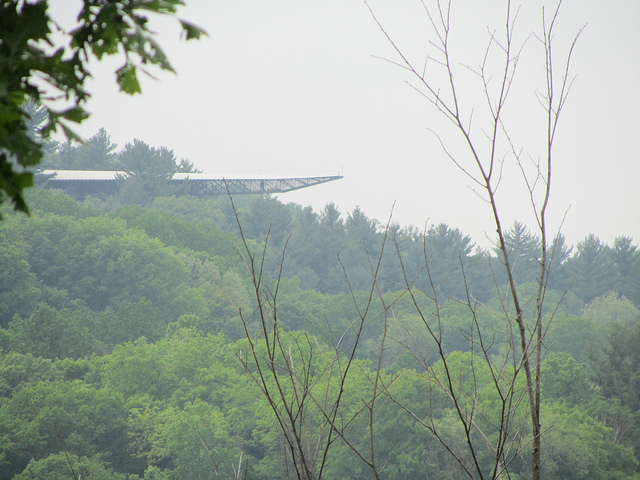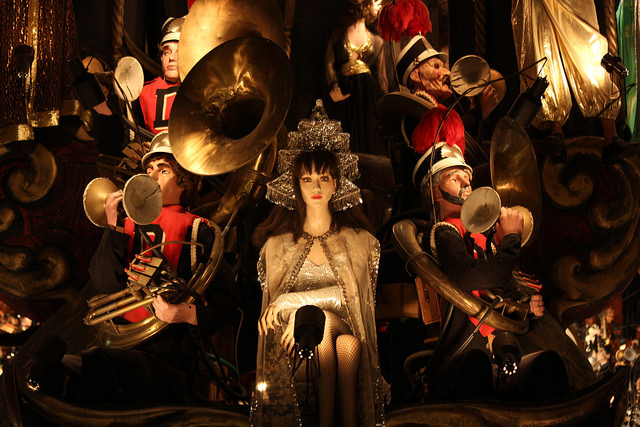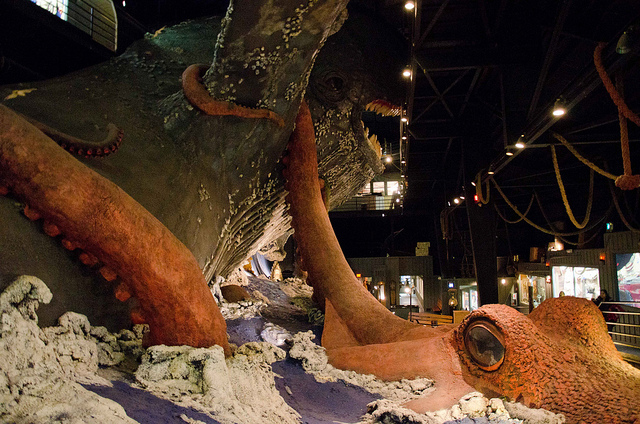The Magical, Trippy, Nightmare-Inducing 'House On The Rock' In Wisconsin
By Emma G. Gallegos in Arts & Entertainment on Nov 14, 2016 7:26PM
Everything about Wisconsin's House On The Rock suggests that it would attract mostly stoners who take road trips centered around Atlas Obscura recommendations and a healthy dose of irony.
But one of the many perhaps unsolvable mysteries of House on the Rock is why it brings in hordes of apparently earnest families piled into minivans—with Grandma in tow, too. Why they pony up as much as $30 to see this unhinged creation—and even spring for a hotel room at the House On The Rock Resort—may never make sense to me.
The house is in Spring Green, just an hour west of Madison, overlooking a lush valley watered by creeks that feed into the Wisconsin River. The name of the house is the only straightforward thing about it. It is quite literally a house built on top of a rock.
Its creator Alex Jordan Jr. began work on the sprawling creation in 1945. The attraction's brochure says it was never meant to be a museum and quotes Jordan as saying "one thing just sort of led to another." In 1960, it was opened to the public. The proceeds from ticket sales were invested right back into expanding the attraction and executing Jordan's unsettling vision.
There's a rumor that Jordan built the house to compete with his neighbor Frank Lloyd Wright at Taliesin East, just 10 minutes away on Highway 23. But like a lot of the stories about the house and its creator, it's probably bunk. Save for some nods to Japanese architecture and proximity, these two wildly different (and wildly popular) Wisconsin tourist destinations have little in common.
Wright's architecture is dominated by clean lines and executed according to painstaking blueprints. Order reigns. Each structure is in perfect harmony with its surroundings and takes advantage of natural light. House on the Rock, on the other hand, feels like you're in the dark id of its creator's subconscious. If the house can be said to have any sort of order, it's all according to dream—or nightmare—logic. Though it sits up high on a rock where there's plenty of light, the interior is largely dingy and dusty and cluttered. Neil Gaiman set part of American Gods here, but he wrote that the truth of the place was stranger than fiction: "I had to tone down my description of it and leave things out in the book in order to make it believable."
I arrived with my friends on a Saturday afternoon in late summer when we had less than three hours to make our way through each of the three sections of The Ultimate Experience before closing. At the ticket counter and then the beginning of each section, employees told us, in that passive-aggressive way unique to the Upper Midwest, that there was no way we could make it through in such a short time.
I think they were worried we might not get to appreciate each of Alex Jordan Jr.'s lovingly chosen and crafted artifacts, but there was an edge in their voices that made me wonder if lollygaggers would be rounded up at 5:01 p.m. and dragged down to a dungeon underneath the rock. We made it through, walking at a good clip through the labyrinth of structures for over two-and-a-half hours and pausing only for a couple of the showstoppers. That should give you an idea of the scale of the thing—of all the things, really.
The house is full of collections that are lazy shorthand for horror in B movies. The sheer volume of porcelain dolls and mannequins staring out into the middle distance is stunning. And you're never far from a coin-operated music boxes, automated doll orchestras or carousels playing tinny melodies warped with age.
The aesthetic is maximalist, and it represents everything that Marie Kondo is up against in this country. The house is packed to the gills with kitschy Americana—the kind of thing you can imagine seeing at a carnival or a church tag sale a century ago. It is a delirious, out-of-control boyhood fantasy from an era before TV and movies. One section "The Streets of Yesterday" actually recreates a small American town at the turn of the 20th century. There are collections of circus toys and clowns, doll houses, model airplanes and ships, toy banks, puppets, masks, Rube Goldberg machines, bare-breasted mermaids, freak show posters (Frog Girl!), actual cars, Chinese lanterns, stained glass windows, full-sized and miniature carriages, morality play dioramas warning of fire and brimstone, elaborate ivory carvings, automated fortune tellers, racist tchotchkes and dolls, so many dolls.
Some antiques are real, some were created in service of the eccentric fantasy and you're left to your own devices to decide which is which. That's fine, since the idea of authenticity here is well beside the point. The obvious fakes are kooky fun, like knock-off Tiffany lamps, 24-barrel rifles and armor for a dog in a section dedicated to so-called medieval weaponry. Each section has its own centerpiece or two.
My favorite is a multi-story nautical scene that shows a toothy whale locked in mortal battle with a giant octopus. A ramp winds up above the scene that is 200 feet tall and, according to a brochure, as long as the Statue of Liberty is on its side. The walls are lined with displays of nautical models and memorabilia, including a replica of the Titanic.

The Infinity Room really does just keep going (Photo by featherynscale via the Flickr Creative Commons)
Most of the structures don't really seem to take advantage of their location on top of a rock. One exception is the Infinity Room, which is a long, narrow room with floor-to-ceiling windows that juts out 218 feet. There's a window in the floor at the very tip that gives you a dizzying view of the forest 156 feet below.
But the scene that best represents House on the Rock's eerie nostalgia is a dim red room housing the "world's largest indoor carousel." Piped-in music with a robust percussion section blasts as an epic carousel lit by 20,000 bulbs revolves. A host of angels dangle from above. This would be an excellent place for a bad drug trip, scaring a small child or very sensitive adult or filming a movie scene that involves a murderous clown chase (but for some reason 10,000 Maniacs shot a music video here).
The experience varies depending on which time of year you go. Right now the house is gearing up for the Christmas season. Starting on Nov. 17, they'll be rolling out a collection of 6,000 Santas and decorating the house for the occasion. Portions of the attraction are shut down after Nov. 13 to accommodate the chilly weather until early spring. In October, the attraction stays open after hours and is transformed into a haunted house, complete with fog, strobe lights and performers that jump out from the many dark corners. The website teases it this way: "If you have ever wondered if the dolls come alive at night or if you find the displays troubling during the day, wait until you see them in the dark."
Whenever you go, this place is a hell of a trip—whether or not you choose to hotbox your car before your journey.
House on the Rock is located at 5754 State Road 23 in Spring Green, Wisconsin.



